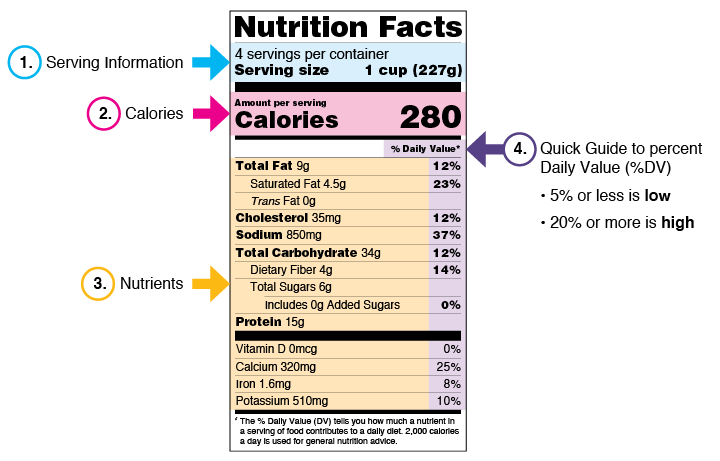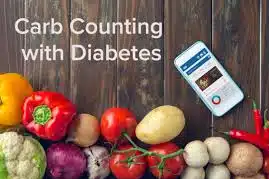Diabetes Nutrition Needs
The Plate Method
What is the Plate Method?
It’s important to understand diabetes nutrition needs and how to incorporate the right foods into your diet. The Diabetes Plate Method is an easy way to create healthy meals to help manage blood sugar for diabetes nutrition needs. Indeed, using this method, you can create perfectly portioned meals with a healthy balance of vegetables, protein, and carbohydrates—without counting, calculating, weighing, or measuring. To sum up, all you need is a plate!
Our plate size determines the size of our portions, so starting with the right-sized plate puts you ahead of the game. We recommend one that’s about 9 inches across. Now that you have the right plate, it’s time to fill it! Imagine two lines drawn on your plate, breaking it up into three sections:

Plate Sections
Fill half your plate with non-starchy vegetables.
Non-starchy vegetables are lower in carbohydrates, so they do not raise blood sugar very much. These are great for diabetes nutrition needs. They are also high in vitamins, minerals, and fiber, making them an essential part of a healthy diet. Filling half your plate with non-starchy vegetables means you will get plenty of servings of these superfoods!
Non-starchy vegetables include:
- Asparagus
- Broccoli or Cauliflower
- Brussels Sprouts
- Cabbage (green, red, napa, bok choy, Chinese)
- Carrots
- Celery
- Cucumber
- Eggplant
- Leafy greens such as kale, collards, mustard greens, or Swiss chard
- Green beans, pea pods, snow peas, and sugar snap peas
- Peppers such as bell peppers and hot peppers
- Salad greens such as lettuce, spinach, arugula, endive, and other salad mixes
- Squash such as zucchini, yellow squash, chayote, spaghetti squash
- Tomatoes
Fill one quarter of your plate with carbohydrates.
Carbohydrates are sugar molecules that break down into glucose. Foods rich in carbohydrates include grains, starchy vegetables, beans and legumes, fruit, yogurt, and milk. Consequently, these foods have the most significant effect on blood sugar. In general, you will want to monitor your carbohydrate intake when considering your diabetes nutrition needs.
Limiting your portion of carbohydrate foods to one quarter of your plate can help keep blood sugars from rising too high after meals.
Examples of Carbohydrate Foods Include:
- Whole grains such as brown rice, bulgur, oats/oatmeal, polenta, popcorn, quinoa, and whole grain products (bread, pasta, tortillas)
- Starchy vegetables such as acorn squash, butternut squash, green peas, parsnips, plantain, potato, pumpkin, and sweet potato/yam
- Beans and legumes such as black, kidney, pinto, and garbanzo beans
- Fruits and dried fruit
- Dairy products like milk, yogurt, and milk substitutes (i.e. soy milk)
Fill one quarter of your plate with lean protein foods.
Foods high in protein such as fish, chicken, lean beef, soy products, and cheese are all considered “protein foods.”
Consequently, protein-rich foods (especially those from animal sources) often contain saturated fat, which may increase your risk of heart disease. Lean proteins are lower in fat and saturated fat, making them a healthier choice.
When choosing your protein source, keep in mind that some plant-based protein foods (like beans and legumes) are also high in carbohydrates.
Examples of Lean Protein Foods Include:
- Chicken, turkey, and eggs
- Fish like salmon, cod, tuna, tilapia, or swordfish
- Shellfish like shrimp, scallops, clams, mussels, or lobster
- Lean beef cuts such as chuck, round, sirloin, flank, or tenderloin
- Lean pork cuts such as center loin chop or tenderloin
- Lean deli meats
- Cheese and cottage cheese
- Plant-based options, like “impossible” meats, beans, legumes, tempeh, and tofu.
Choose water or a low-calorie drink.
Undoubtedly, water is the best choice because it contains no calories or carbohydrates and has no effect on blood sugar. In addition, other zero- or low-calorie drink options include:
• Unsweetened tea (hot or iced)
• Non-sweet coffee (hot or iced)
• Sparkling water/club soda
• Flavored water or sparkling water without added sugar
• Diet soda or other diet drinks/zero sugar drinks
Reading Labels
1. Serving Information:
When looking at the Nutrition Facts label, first take a look at the number of servings in the package and the serving size. Serving sizes are standardized to make it easier to compare similar foods; they are provided in familiar units, such as cups or pieces, followed by the metric amount. Secondly, the serving size reflects the amount that people typically eat or drink. In other words, it is not a recommendation of how much you should eat or drink. For this reason, pay attention to the serving size, especially how many servings there are in the food package.
2. Calories:
Calories provide a measure of how much energy you get from a serving of this food. To achieve or maintain a healthy body weight, balance the number of calories you eat and drink with the number of calories your body uses. 2,000 calories a day is used as a general guide for nutrition advice. Your calorie needs may be higher or lower and vary depending on your age, sex, height, weight, and physical activity level.
Remember: The number of servings you consume determines the number of calories you actually eat. Alternatively, eating too many calories per day is linked to overweight and obesity.

3. Calories:
This section shows you some key nutrients that impact your health. You can use the label to support your personal dietary needs – look for foods that contain more of the nutrients you want to get more of and less of the nutrients you may want to limit. Ultimately, nutrients to get less of: Saturated Fat, Sodium, and Added Sugars. Saturated fat, sodium, and added sugars are nutrients listed on the label that may be associated with adverse health effects. As a result, Americans generally consume too much of them, according to the recommended limits for these nutrients.
4. The Percent Daily Value:
The % Daily Value (%DV) is the percentage of the Daily Value for each nutrient in a serving of the food. The Daily Values are reference amounts (expressed in grams, milligrams, or micrograms) of nutrients to consume or not to exceed each day. The %DV shows how much a nutrient in a serving of a food contributes to a total daily diet. The %DV helps you determine if a serving of food is high or low in a nutrient.
Carbohydrate Counting
Carbohydrates are important because they provide energy and essential vitamins and minerals. Calories from food derive from three nutrients: protein, fat, and carbohydrate. Each nutrient affects glucose differently, but carbohydrate has the greatest impact. Within minutes of eating carbohydrates, sugars and starches are broken down into glucose, and glucose levels start to rise. Insulin helps the body absorb glucose and use it for energy.
There are 3 types of carbohydrates:
-Sugars, such as the natural sugar in fruit and milk, or the added sugar in soda and many other packaged foods.
-Starches, including wheat, oats, and other grains; starchy vegetables such as corn, peas, and potatoes; and dried beans, lentils, and peas.
-Fibers, the part of plant foods that aren’t digested but helps you stay healthy.
Sugars and starches raise your blood sugar levels but fiber doesn’t.
Carbohydrates are measured in grams. On packaged foods, you can find total carb grams on the Nutrition Facts Label. You can use a carb-counting app to find grams of carbs in foods and drinks.
It’s important to know that…
1 carbohydrate choice = 15 grams carbohydrate.
Women often need about 45-60 grams of carbohydrate (3-4 choices) at each
of 3 meals and 15 grams carbohydrate (1 choice) for snacks as needed.
Men often need 60-75 grams of carbohydrate (4-5 choices) at each of 3
meals and 15-30 grams carbohydrate (1-2 choices) for snacks as needed.
Aim to eat about the same amount of carbohydrates at each meal to keep your blood sugar levels steady throughout the day. If you need help with counting carbohydrates and adjusting your meal plan seek the help of a Registered Dietitian.

Diabetes and Alcohol
If you never or rarely drink alcohol, you’re not alone—in fact, people with diabetes drink about half as much as other adults. Why? Maybe their doctors cautioned them that drinking and diabetes don’t mix. Perhaps some have health conditions that are incompatible with alcohol. Or maybe they’re just concerned about all those calories—and carbs.
But is the occasional cocktail or glass of wine really so bad? After all, a daily drink does have its benefits. Still, diabetes can make happy hour pretty confusing. Here’s what you need to know about drinking and how to do it safely. Drinking is individualized and there’s no universal rule for how to do it safely when you live with diabetes. Talk to your doctor about your drinking habits and they can provide you with tips and tricks for how drink in a way that works for you.
The Benefits
For instance, you’ve probably heard that alcohol is good for your heart. But that’s an oversimplification. Take a look at the numbers and you’ll find that only moderate drinkers have less cardiovascular disease. Those on the opposite ends of the spectrum—people that drink heavily and those that don’t—have a greater risk.
But what exactly is moderate drinking? It’s one drink a day for women and up to two per day for men. However, that “drink” is a lot smaller than some people think: just five ounces of wine, a 12-ounce beer, or one and a half ounces of 80-proof spirits.
A daily cocktail or two may improve blood sugar (blood glucose) management and insulin sensitivity. If you have one or more drinks a day, you may find that your A1C is lower than during times you weren’t drinking. But if you don’t drink regularly, this doesn’t mean you should start. After all, other aspects of moderate drinkers’ lives may be behind the link.
Too much drinking, on the other hand (more than three drinks daily), can lead to higher blood sugar and A1C.
The Risks
Despite the potential health perks of drinking alcohol, there are some cautions as well. The biggest concern is hypoglycemia (low blood sugar). When drinking alcohol is combined with the medications most often used to treat diabetes—particularly insulin and sulfonylureas, low blood sugar can result. While a glass of wine with dinner probably isn’t a big deal, a mojito on an empty stomach at happy hour is.
Blame it on your liver. This organ stabilizes glucose levels by storing carbohydrates and releasing them into the bloodstream between meals and overnight. It’s also the body’s detoxification center, breaking down toxins like alcohol so the kidneys can easily flush them away.
Trouble is, it’s not great at multitasking. Your liver will choose to metabolize the alcohol over maintaining your blood sugar, which can lead to hypoglycemia. The liver often makes this choice when you drink without eating food—so consider snacking while you sip.
Because many of the symptoms of hypoglycemia—such as slurred speech, drowsiness, confusion, or difficulty walking—are also symptoms of being drunk, it can be difficult to tell the two apart. And if you often have hypoglycemia unawareness, a condition in which you don’t recognize you’re going low, drinking becomes especially dicey. Timing may also be an issue, as hypoglycemia can strike hours after your last drink, especially if you’ve been exercising.








